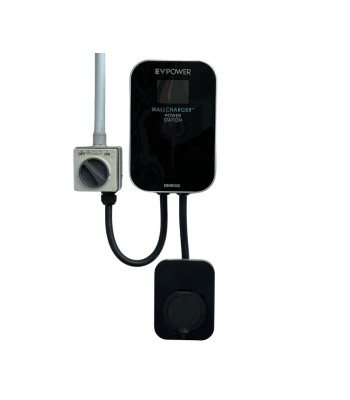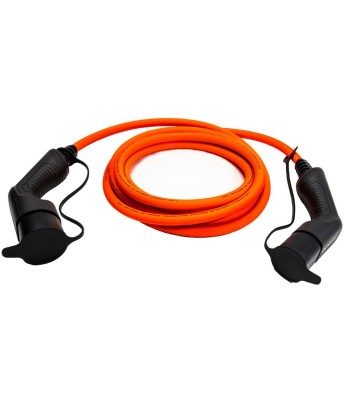WELCOME
The electric vehicle revolution is rolling in. Governments around the world and car manufacturers are jumping on board which means a tonne of new language to learn and use.
OEM Audio Ltd have been selling their own EV Power charging cables since 2016 and know a thing or two about EV charging! We've put together a handy glossary that will help make the lingo less of a mystery. And if you want to speak to a human call us
AC = alternating current, meaning, that the current moves in a waveform in a positive and negative direction. AC is typical for the powerlines and typically used in houses.
AC Charging means using an onboard charger, that is, an AC/DC converter onboard the electric car.
Arcing = When electricity jumps from one connection to another. For example if you don't push a 16 Amp plug in to the 16 Amp socket far enough then the electricity flow will be disrupted. There is a gap between where the power comes out of the wall and the metal pins. Your EV charging cable will get hot and safety features of the EVSE act to stop the cable from working and your car won't charge.
Auto Charge Recovery = A feature of the EV Power range. When the device has interrupted the supply of power the unit will wait, and then three minutes later try again and hope for a successful connection. Handy in those areas where for example ‘ripple control’ can momentarily change the supply.
CHAdeMO = Japanese and international association to promote DC fast charging
Charging Station = A location where one or more charging points are located
Charging Point = A single outlet for EV charging
CE Standard = CE marking is a certification mark that indicates conformity with health, safety, and environmental protection standards for products sold within the European Economic Area (EEA). The CE marking is also found on products sold outside the EEA that have been manufactured to EEA standards.
CEE / Caravan Plug = Industrial power plug offering safety, durability and faster charging time because they can draw 16 Amps out of an electric circuit. The plug has temperature sensors
Charger = The electrical unit that that converts power grid AC current to a DC current suitable to charge a battery.
Charging cables are usually sold with plug-in electric cars. Simple charging cables don’t require any specific installation, the cable is simply plugged into an ordinary household outlet. In NZ, WorkSafe recommends that you ask your electrician to wire a separate circuit with an Type B RCD. You also need to follow the instructions included with every EVPower charger cable on safe use.
Charging Speed = It depends on the size of your battery, how far you have driven, and the amperage of the charging system.
Most electric cars, and primarily plug-in charged hybrids, cannot be charged faster than 7.2 kW on AC power. Using a faster charger is not dangerous for the car, and does not produce more power than the car can receive.
Keep in mind that most of the time, the battery will not be empty when you plug in, just like your cell phone.
DC =direct current, meaning that the current only moves in one direction. DC current is used for power transmission over great distances because it leads to less inductive losses.
DC Charging indicates using an offboard charger, that is, a charger located at the charging station, and not in the vehicle.
Earth leakage protection = EVPower EVSE includes circuit breaker device. It detects small stray voltages on the metal enclosures of electrical equipment, and interrupts the circuit if a dangerous voltage is detected.
EV = Electric vehicle
EVSE = Electric Vehicle Supply Equipment. Cables and wall chargers simply deliver electricity to the car. Electronics on board the car transform the power into the proper form to charge the battery. The car also has a maximum power rating which means, depending on the wiring it can only charge up to a certain speed.
IC-CPD device = ‘In Cord – Control and Protection Device’. It is another way of describing a device in the box in the middle which contains electronics to make sure that the EV is charged safely. For example, telling the EV that it can only consume a maximum of 8A.
IEC = International Electrotechnical Commission, an international body for electrical standards
IEC 60529 has been developed to rate and grade the resistance of enclosures of electric and electronic devices against the intrusion of dust and liquids.
The required laboratory conditions for compliance with IPXX ratings (to measure the level of protection offered by the enclosure) include calibrated nozzles, controlled pressure and testing for up to 30 mins.
IEC 62752 standard is a standard for a product which connects the electric vehicle with a standard household socket.
IP (or "Ingress Protection") ratings are used to define levels of sealing effectiveness of electrical enclosures against intrusion from foreign bodies (tools, dirt etc) and moisture. Standards are outlined by IEC 60529.
• IP ratings are assessed in a lab, with products immersed in still, clean water
• The test doesn’t account for real-life situations.
• The devices don’t have to be on during testing – if an electronic device is powered on underwater and is running programs, its internal temperature and pressure will increase, negatively affecting the depth of water the product can withstand. Heat can cause the case to expand which may allow water to enter the IC-CPD box.
IP65
First Digit (solid/dust resistance)
6 = Totally dust tight. Full protection against dust and other particulates, including a vacuum seal, tested against continuous airflow.
Second Digit (moisture protection)
5 = Protection against direct low pressure jets. Nozzle 6.3mm / distance 2.5 - 3m / water flow rate 12.5 l/min for 3 min
In real-life an IP 65 rating should allow outdoors use of a portable charging cable. However, where there is persistent light rain, hours of driving rain, the EVSE should be offered some form of protection as these conditions are not covered by its IP 65 or 55 rating. Water and electronics do not mix and common sense is required when charging your EV in all weathers.
kWh = Kilowatt hour, equal to 1000 watt hours. The amount of energy expended in one hour by one kilowatt-hour.
kW = Kilowatts, a measure of power, A unit of energy, usually used for electrical energy, but also equivalent to other measures of energy, such as 800 calories.
Level 1 Generally, level 1, level 2 and level 3 are the American terms for what the Brits mostly call slow, fast and rapid charging. Level 1 Charging is the technical jargon (used more commonly in other countries) for plugging your car into an ordinary household outlet using a charging cable.
Level 2 charging means using home charging station, an EV Power wall charger can deliver 32 Amps.
Level 3 charging. Level 3 is the high-power, DC supply, with the AC supply converted to DC inside the charging station. This is the sort you’ll find at some car parks and dedicated charging areas.
Mennekes = Same thing as a Type 2 connector. Mennekes is a company in Europe and they make Type 2 connectors, that's where the name came from. Commonly referred to as circular in shape, with a flattened top edge (or a D on it's side).
Overcurrent protection = protection against excessive currents or current beyond the acceptable current rating of equipment.
Overvoltage protection = is a power supply features which cuts -off the supply whenever input voltage exceeds a certain unsafe value
PHEV = Plug-In Hybrid Electric Vehicles
Protection class IP65 = Water resistant. *Do NOT leave in standing water. Also see (IP)
Public Charging Stations = a private or commercial venture for a fee or free, sometimes offered in partnership with the owners of the parking lot. This charging may be slow or high speed and often encourages EV owners to recharge their cars while they take advantage of nearby facilities. Examples include charging at work, parking at shopping malls, and public transit stations. Learn more.
Typically, AC public charging stations have a Type2 plug. At OEM Audio we stock Type 2 cables suitable for Type 1 and Type 2 EV/PHEV.
RCD Type B - A device that quickly breaks an electrical circuit to prevent serious harm from an ongoing electric shock.
RFID tags are a type of tracking system that uses smart barcodes in order to identify items. RFID is short for “radio frequency identification. An EV Power Wall Charger with RFID tags will only supply power to a user with the corresponding RFID tag.
SAE = An organization for standards in aerospace and automotive industries
SAE J1772 Is a type of charging connector also known in NZ as a Type 1.
Single phase requires the single wire to connect the circuit. The voltage of the single phase is 230V.
Short circuit protection is protection against excessive currents or current beyond the acceptable current rating of equipment and it operates instantly. As soon as an overcurrent is detected, the device trips and breaks the circuit
Tesla charging equipment can be Tesla branded or generic. If your Tesla has a type 2 socket you can charge using a lead with a Type 2 handle/connector.
Three phase (3-phase) needs 3-wires and the three phase voltage is 415V.
Type 1 (J1772) = This is an AC connector (with 5 pins) mainly used in electric vehicles from Asia and America. The Type 1 plug is a single-phase plug which allows for charging power levels of up to 7.4 kW (230 V, 32 A). Fits EV/PHEV ex-Japan or NZ new.

Type 2/Mennekes - It's a socket that can potentially offer charging up to 22kW per hour (if the cable is a 3 phase version). Mostly they come in single phase options for domestic use and charge at 7.4kW per hour.

The most common public AC socket for plugging in to across New Zealand for domestic and light commercial use. NZTA recommended that AC public charging stations provide a Type 2 socket; the driver will be expected to provide their own supply cable that is compatible with their vehicle inlet.

IEC Type 1/SAE J1772 inlet (left); Tesla02 proprietary outlet (centre); IEC Type 2 connector outlet (right)
Wall chargers = Home charging stations/home chargers/home charge points/EVSE (Electric Vehicle Supply Equipment)/wall charger or wall box but refer to the same thing.
A home charging station/wall charger is preferred over constant use of your 3 pin plug outlet. A home charging station/wall charger may or may not have user authentication, or separate metering, but will require wiring* a dedicated circuit to have safe charging. Apartments sharing a wall charger may be set up differently.
**Always use a qualified electrician


-350x400.jpg)

